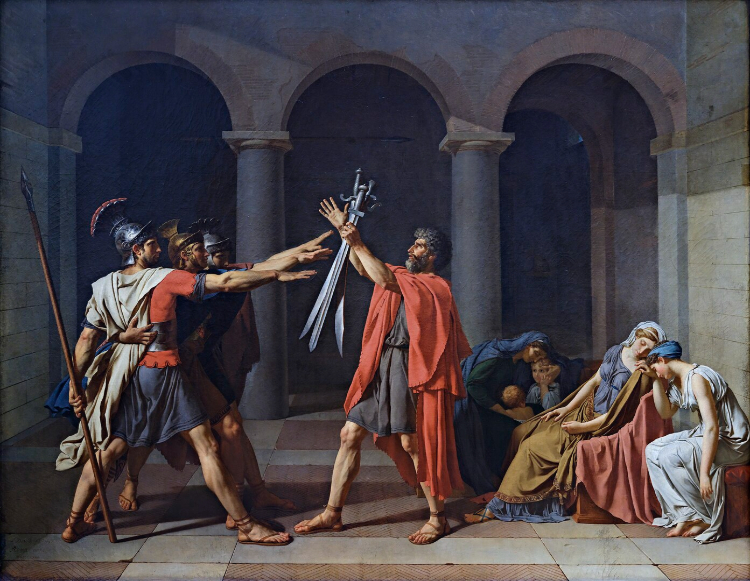Oath of Horatii by Jacques-Louis David

Oath of the Horatii
Who knew that a propaganda piece could be so much fun? Before there was Reefer Madness, there was Oath of the Horatii. Oath of the Horatii was commissioned on behalf of Louis XVI (he of the cake-eating wife) as a symbol of loyalty to the French monarchy. The painting's subject did demonstrate loyalty, but loyalty to the state, not the monarch, becoming a symbol of the French Revolution in 1789.
The painting is a depiction of a Roman story in which the three Horatii brothers pictured were chosen to fight against three brothers of the family of the Curiatii in lieu of two armies going to war. The winning family would win the war for their side. Complicating matters are the women to the right. One was a sister of the Horatii engaged to a Curiatii brother. The other was a sister of the Curiatii married to one of the Horatii brothers.
If you know anything about ancient stories, you know it has a happy ending - not all of the men were killed (only 83% of them) and only one woman was murdered for showing sadness at her fiance's death instead of happiness at Rome's victory.
What a relief!
Neo-Classicism and the Enlightment were highly influenced by ancient Greco-Roman ideas. To further demonstrate rationality, the color palette of the painting is muted and the brushwork is nearly non-existent. These concepts demonstrate the triumph of cool logic over messy emotion.
The background of the painting is left spare to simulate the effect of relief sculpture - a popular style from Greco-Roman times - in which a sculpture projects in 3-D from its surface.
Playing the straight man
Oath of the Horatii is a representative example of the Neo-Classical style. Neo-Classicism was a direct repudiation of the frivolity and tomfoolery of the Rococo style. It emphasized the principles of The Enlightment that gripped Europe in the the 18th century - rational thought triumphing over all.
The men represent this rationality, and thus their forms follow straight lines. The painting's focal point terminates in a series of intersecting straight lines all converging at the hilt of the swords further calling out the importance of linearity and it's tie to rationality.
Lest you think that the Enlightment was enlightened enough to banish sexism, perish the thought! The women are drawn as curves, both as canny criticism of the unseriousness of the Rococo period and as a representation of weakness. Women were believed to be too irrational to govern correctly. They probably would've sought out a diplomatic solution rather than take an oath resulting in the deaths of five men and tearing two families apart.
Silly women!
